
(a)
Interpretation:
How to synthesize the given trisubstituted benzene from the disubstituted benzene is to be shown.
Concept introduction:
If multiple substituents are attached to a phenyl ring, their activating/deactivating qualities are additive, and the regiochemistry tends to be governed by the most activating of those substituents.
The alkyl group is ortho/para director whereas
Answer to Problem 23.55P
The disubstituted benzene used to synthesize the given trisubstituted benzene is
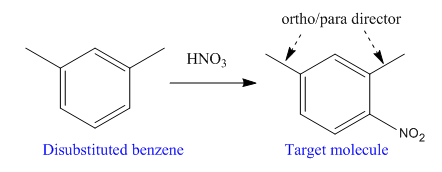
Explanation of Solution
The given trisubstituted target molecule is
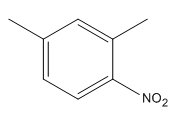
In the above molecule,
This reaction can be carried out using addition of nitric acid
Therefore, the product could be produced by nitrating

The disubstituted benzene used to synthesize the given trisubstituted benzene is shown on the basis of the directing nature of the substituents present at the benzene ring on the target molecule (given trisubstituted benzene).
(b)
Interpretation:
How to synthesize the given trisubstituted benzene from the disubstituted benzene is to be shown.
Concept introduction:
If multiple substituents are attached to a phenyl ring, their activating/deactivating qualities are additive, and the regiochemistry tends to be governed by the most activating of those substituents.
Answer to Problem 23.55P
The disubstituted benzene used to synthesize the given trisubstituted benzene is
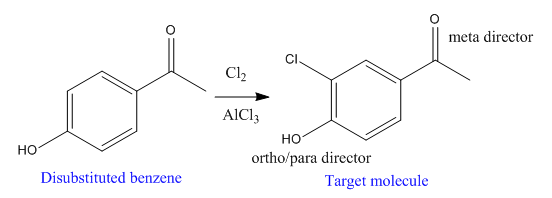
Explanation of Solution
The given trisubstituted target molecule is
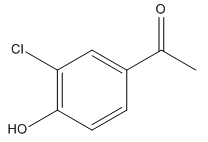
In the above molecule,
Thus, the product could be produced by chlorinating the disubstituted benzene using

The disubstituted benzene used to synthesize the given trisubstituted benzene is shown on the basis of the directing nature of the substituents present at the benzene ring on the target molecule (given trisubstituted benzene).
(c)
Interpretation:
How to synthesize the given trisubstituted benzene from the disubstituted benzene is to be shown.
Concept introduction:
If multiple substituents are attached to a phenyl ring, their activating/deactivating qualities are additive, and the regiochemistry tends to be governed by the most activating of those substituents.
Answer to Problem 23.55P
The disubstituted benzene used to synthesize the given trisubstituted benzene is
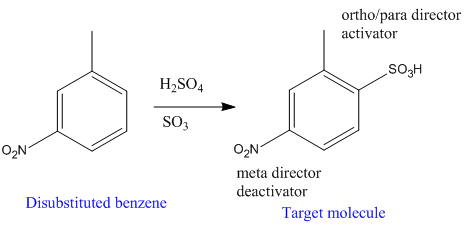
Explanation of Solution
The given trisubstituted target molecule is
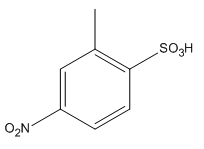
In the above molecule,
Therefore, the product could be produced by sulfonating the disubstituted benzene using fuming

The disubstituted benzene used to synthesize the given trisubstituted benzene is shown on the basis of the directing nature of the substituents present at the benzene ring on the target molecule (given trisubstituted benzene).
(d)
Interpretation:
How to synthesize the given trisubstituted benzene from the disubstituted benzene is to be shown.
Concept introduction:
If multiple substituents are attached to a phenyl ring, their activating/deactivating qualities are additive, and the regiochemistry tends to be governed by the most activating of those substituents.
Answer to Problem 23.55P
The disubstituted benzene used to synthesize the given trisubstituted benzene is
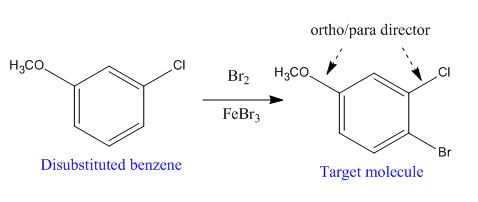
Explanation of Solution
The given trisubstituted target molecule is
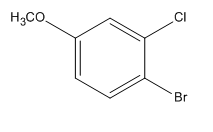
Here, both
Therefore, the target molecule could be produced by brominating the disubstituted benzene using

The disubstituted benzene used to synthesize the given trisubstituted benzene is shown on the basis of the directing nature of the substituents present at the benzene ring on the target molecule (given trisubstituted benzene).
Want to see more full solutions like this?
Chapter 23 Solutions
EBK GET READY FOR ORGANIC CHEMISTRY
- 2Helparrow_forwardplease add appropriate arrows, and tell me clearly where to add arrows, or draw itarrow_forwardWhat I Have Learned Directions: Given the following reaction and the stress applied in each reaction, answer the question below. A. H2(g) + Cl2(g) 2 HCl(g) Stress applied: Decreasing the pressure 1. What is the Keq expression? 2. What will be the effect in the number of moles of HCl(g)? 3. What will be the Equilibrium Shift or the reaction? B. Fe3O4(s) + 4 H2(g) + heat 53 Fe(s) + 4 H₂O(g) Stress applied: Increasing the temperature 1. What is the Keq expression?. 2. What will be the effect in the volume of water vapor collected? 3. What will be the Equilibrium Shift or the reaction? C. 4 NH3(g) + 5 O2(g) 4 NO(g) + 6 H2O(g) + heat Stress applied: Increasing the volume of the container 1. What is the Keq expression?. 2. What will be the effect in the amount of H₂O? 3. What will be the Equilibrium Shift or the reaction?arrow_forward
- Consider the solubility products (Ksp values) for the following compounds:SrSO4 (Ksp = 7.6 x 10−7), BaSO4 (Ksp = 1.5 x 10−9), SrCO3 (Ksp = 7.0 x 10−10), BaCO3 (Ksp = 1.6 x 10−9)Which anion is the harder base, CO32− or SO42−? Justify your answer.arrow_forwardQ1: a) Arrange the compounds in order of decreasing pKa, highest first. ОН ΟΗ ῸΗ дон ОН ОН CI Brarrow_forward(4 pts - 2 pts each part) A route that can be taken to prepare a hydrophobic (water-repellent) aerogel is to start with trichloromethylsilane, CH3SiCl3 as the silicon source. a. What is the chemical reaction that this undergoes to form a product with Si-OH groups? Write as complete of a chemical equation as you can. CI CI-SI-CH3 CI b. The formation of a byproduct is what drives this reaction - what is the byproduct (if you didn't already answer it in part (a)) and how/why does it form?arrow_forward
- b) Circle the substrate that would not efficiently generate a Grignard reagent upon reaction with Mg in ether. CI Br ד c) Circle the Grignard reagents that contain incompatible functional groups. MgBr HO MgBr MgBr MgBr MgBr HO MgBrarrow_forwardQ2: Predict all organic product(s), including stereoisomers when applicable. PCC OH a) CH2Cl2 Page 2 of 5 Chem 0310 Organic Chemistry 1 HW Problem Sets b) .OH Na2Cr2O7, H+ OH PCC CH2Cl2 c) OHarrow_forwardd) Circle the substrates that will give an achiral product after a Grignard reaction with CH3MgBr. Harrow_forward
 ChemistryChemistryISBN:9781305957404Author:Steven S. Zumdahl, Susan A. Zumdahl, Donald J. DeCostePublisher:Cengage Learning
ChemistryChemistryISBN:9781305957404Author:Steven S. Zumdahl, Susan A. Zumdahl, Donald J. DeCostePublisher:Cengage Learning ChemistryChemistryISBN:9781259911156Author:Raymond Chang Dr., Jason Overby ProfessorPublisher:McGraw-Hill Education
ChemistryChemistryISBN:9781259911156Author:Raymond Chang Dr., Jason Overby ProfessorPublisher:McGraw-Hill Education Principles of Instrumental AnalysisChemistryISBN:9781305577213Author:Douglas A. Skoog, F. James Holler, Stanley R. CrouchPublisher:Cengage Learning
Principles of Instrumental AnalysisChemistryISBN:9781305577213Author:Douglas A. Skoog, F. James Holler, Stanley R. CrouchPublisher:Cengage Learning Organic ChemistryChemistryISBN:9780078021558Author:Janice Gorzynski Smith Dr.Publisher:McGraw-Hill Education
Organic ChemistryChemistryISBN:9780078021558Author:Janice Gorzynski Smith Dr.Publisher:McGraw-Hill Education Chemistry: Principles and ReactionsChemistryISBN:9781305079373Author:William L. Masterton, Cecile N. HurleyPublisher:Cengage Learning
Chemistry: Principles and ReactionsChemistryISBN:9781305079373Author:William L. Masterton, Cecile N. HurleyPublisher:Cengage Learning Elementary Principles of Chemical Processes, Bind...ChemistryISBN:9781118431221Author:Richard M. Felder, Ronald W. Rousseau, Lisa G. BullardPublisher:WILEY
Elementary Principles of Chemical Processes, Bind...ChemistryISBN:9781118431221Author:Richard M. Felder, Ronald W. Rousseau, Lisa G. BullardPublisher:WILEY





